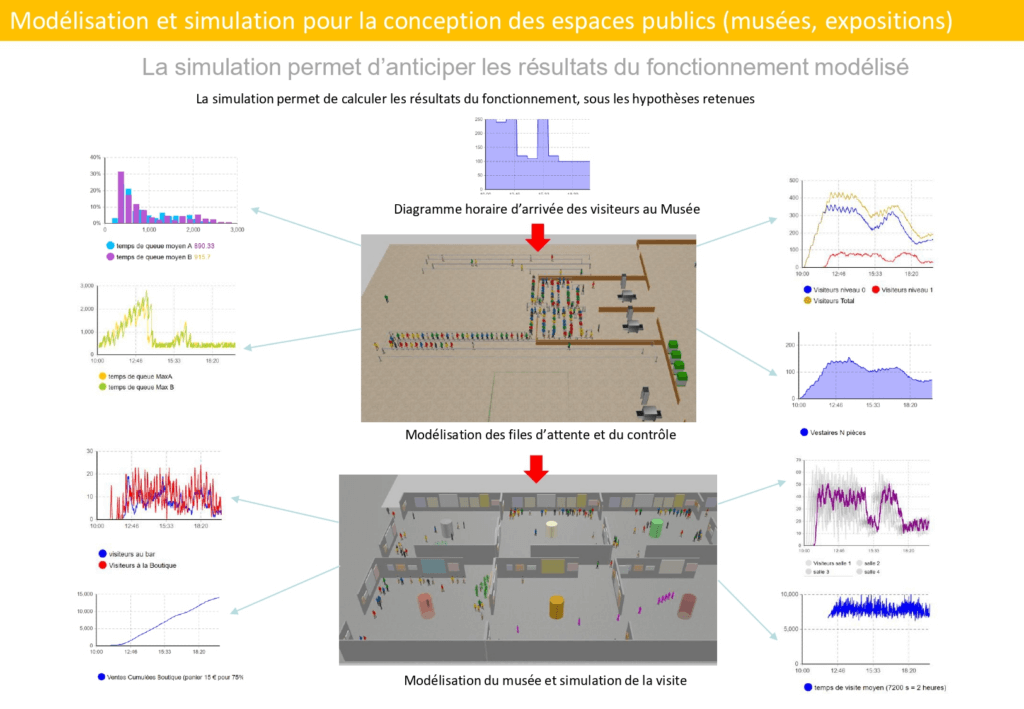Modeling Visitor Flows and Optimizing Spaces
Visitor flow simulation to optimize queues, entrance management, space occupancy, and visitor comfort. Modeling and simulation of visit paths for individuals and groups.

Accurately Model Visitor Flows, Improve Layouts, and Optimize the Museum Experience
Dynamic multi-agent simulation is a powerful tool to model the real-world operations of a museum. This approach provides highly detailed, realistic simulations of visitor flows, covering every aspect from queue management to exhibition paths, as well as café, shop, and cloakroom usage.
Emergent Behaviors Based on Autonomous Agents
Unlike static models, multi-agent simulation does not predetermine visitor flows. Instead, movement patterns emerge dynamically from the individual behaviors of each agent — representing museum visitors. These behaviors are continuously recalculated in real-time, based on:
Visitor characteristics (age, group type, available time, interests)
Spatial constraints (architectural layout, crowd density, obstacles)
Interactions with other visitors and staff
This results in realistic, adaptive modeling of how a museum operates, particularly under high visitor demand.
A Decision-Making Tool for Museum Design and Operations
Multi-agent simulation for museums is ideal for supporting the design, planning, and operational management of cultural spaces. It enables stakeholders to:
Evaluate the building’s real visitor capacity
Identify bottlenecks and congestion zones (queues, elevators, access control)
Adjust space layouts based on projected visitor attendance
Test various scenarios for entrance areas (ticketing, access control, security checks)
Optimize visitor flow to commercial areas such as cafés and gift shops, according to their location and the museum’s overall architecture
Anticipate Visitor Behavior with Configurable Simulations
This approach allows teams to test different operational scenarios by adjusting key parameters:
Expected visitor numbers and profiles
Space configurations and layout designs
Service locations (cafeteria, cloakrooms, shops)
Opening hours and time slots
This helps museum teams, architects, and facility managers anticipate actual visitor behaviors, make informed decisions based on simulated data, and improve both the visitor experience and staff working conditions.
Multi-Agent Simulation: A Strategic Tool for Museums
Museum visitor flow simulation using multi-agent models provides a strategic advantage in the design, management, and optimization of cultural venues. It offers an interactive, forward-looking understanding of how spaces function, contributing to organizational performance and public satisfaction.
Learn more about the variables used in our simulations on the Variables page.
Watch Our Museum Simulation Videos
- Flux piétons et usages des espaces publics
- Méthodologie d’étude des espaces publics et de leurs usages
- Simulation des flux de visiteurs au musée
- Flux piétons – Tour Montparnasse
- Flux piétons – Notre Dame de Paris – modélisation et simulation des flux
- Flux piétons dans les espaces publics – Parc d’expositions et centre de congrès
- Flux piétons – simulation Bourse de Bruxelles
- Flux dans les espaces publics – Animaux et visiteurs de la Ferme pédagogique
